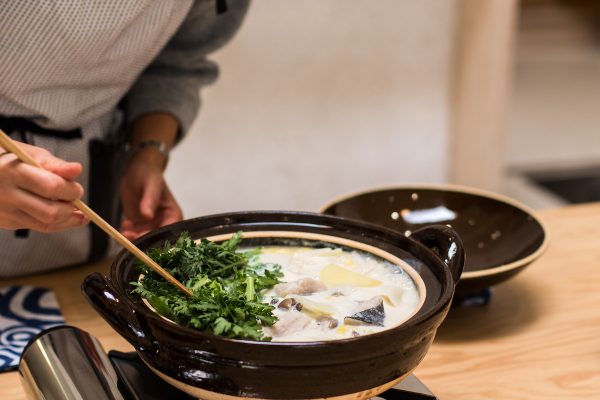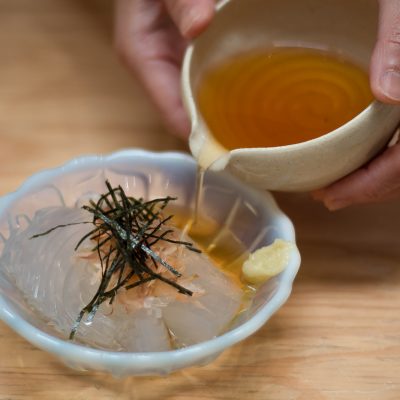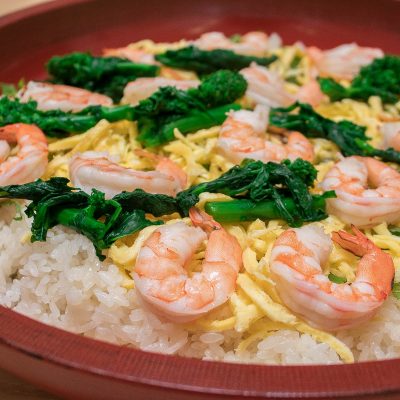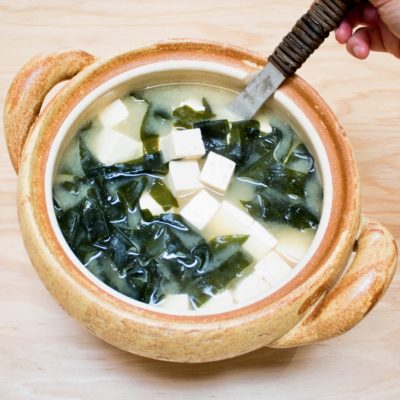Ginger Amazake Nabe – a healthy and delicious donabe hot pot recipe and it’s one of my favorite hot pot dishes of the season to bring comfort and keep me warm! Hope you get to try it home. Feel free to substitute chicken with just vegetables or seafood, to make it your own way.
Tag Archives: Vegetarian option
Tokoroten Noodles with Dashi Vinegar Sauce
Tokoroten is a very popular and traditional Japanese dish and it’s essentially simple kanten (agar jelly), cut into noodles. Tokoroten itself doesn’t really have flavors, so it’s served with sauce and toppings. It’s served chilled, so people enjoy tokoroten especially during the summer. It’s often served at Japanese traditional tea/ dessert parlors, and there are also vendors specialized in serving only tokoroten! In Tokyo, where I am from, and most of eastern Japan, tokoroten is enjoyed with vinegar-soy based sauce, so the vinegar can help alleviate the fatigue while the cold temperature of the dish helps cooling down your body. Tokoroten itself has very few calories, so it’s very light yet quite satisfying. I’ve been wondering why this dish has never caught up its popularity in the US yet…so, I thought I should introduce this beloved Japanese humble dish here. With my version, the sauce includes dashi, so it’s mild with extra layer of umami flavors.
To cut the kanten into tokoroten noodles, I use a traditional tokoroten-tsuki (a traditional tool designed specifically for cutting tokoroten noodles). It’s not only very easy to use, but it’s really fun to cut noodles with this.
In Kansai (including Kyoto and Osaka) and many parts of western Japan, tokoroten is typically enjoyed with sweet syrup and served as a dessert. So, my friends from Kyoto say they think tokoroten with vinegar-soy sauce is so strange.
How to Grill with Mizu Konro
Iga-yaki Water Grill, Mizu Konro is a portable grill set for tabletop charcoal grilling. It’s easy to set up, and once you have the ingredients ready, you can simply start grilling them on Mizu Konro at the table. The aroma of binchotan charcoal adds really wonderful flavors to the ingredients, and you can keep grilling and eating until you are full! The tabletop grill also makes a meal a fun event, as everybody can participate in the cooking and share the whole experience.
Make sure to enjoy using Mizu Konro outdoor or a very well-ventilated area if inside.
Black Cod Hot Pot in Saikyo Miso & Soymilk Broth

Saikyo miso is a traditional white miso from Kyoto, Japan. The color is pale and it has a natural umami-rich sweet flavor due to the higher content of koji rice (malted rice) in the miso. The sodium level is also much lower than other types of miso, so you can use a good amount of it to enjoy its rich flavor in a soup, etc. without making the dish too salty. This hot pot dish has the combination of dashi, soymilk, and Saikyo miso in the broth, so the flavor is rich and complex. Make sure to use the real Saikyo Miso from Kyoto and pure rich soymilk (with no additives) such as Banrai Soymilk.
Buttery fish like cod is perfect for this broth, other types of seafood or even chicken would certainly work in this dish, too.
Classic Chicken and Root Vegetable Stew
This is a traditional stew called Chikzen-ni, and is often served in a Japanese New Year meal, and one of my favorite New Year dishes since I was a child. The root vegetables such as burdock, lotus, carrot and sato-imo (taro) are cooked with konnyaku (yam jelly), dry shiitake, and chicken in dashi, and seasoned with soy sauce and black sugar. The flavor is so rich and you can really enjoy the nice earthy flavors.
When I serve this dish in the New Year, I cut the lotus and carrot into decorative shapes, but for any regular occasion, that’s not necessary.
Although I love the flavor of the chicken in Chikuzen-ni, this dish can easily be converted into a vegan dish by simply omit the chicken and use vegan dashi (i.e. kombu and dry shiitake dashi). You can also make it gluten-free by substituting the soy sauce and white tamari with tamari soy sauce.
Shrimp and Rapini Chirashi Sushi
Chirashi Sushi (sushi rice with scattered toppings) is a great dish for celebration, and I make this colorful dish for Japanese New Year or other party occasions. The most unique part about this dish is that the rice is seasoned with daidai citrus juice, instead of rice vinegar to make the sushi rice. Daidai is a Japanese citrus that is similar to orange but with brighter aroma and flavor. When the rice is seasoned with daidai juice, the beautiful aroma of daidai spreads around it and it’s so appetizing.
Egg crepes, rapini and shrimp create beautiful colorful visual and and the flavors are also wonderful together, too. Feel free to substitute them with other toppings of your choice for fun.
Egg Drop Vegetable Soup
This soup is full of flavors and very satisfying. The addition of the black vinegar gives the nice umami-rich accent to the dish. The fluffy egg with vegetables make wonderful layers of textures, too. I like to sprinkle some sansho powder to the soup for extra kick, but it’s totally optional.
Make Your Own Shoyu Ramen Hot Pot
Making ramen is easy and fun, especially if you cook and serve as donabe hot pot right at the table. I like adding the chopped nira (garlic chives) to the ramen right before serving, but if you can’t find nira, you can substitute with thinly-sliced green onion and serve as a topping, instead. Enjoy with a couple of simple toppings or a make a platter of a wide selection of toppings to choose from for fun.
Tofu and Wakame Miso Soup
Tofu and wakame miso soup is such a classic Japanese soup, and it’s one of my ultimate comfort foods. Because Miso-shiru Nabe has such a high heat retention ability, the soup stays very hot for a long time after turning off the heat. Make sure to turn off the heat as soon as you add the miso, and never boil the soup, so you can really enjoy the most aromatic stage of the miso. If you have access, salt-preserved wakame (or sometimes it’s called “fresh wakame“) is recommended as it gives the nice fresh texture to the soup, and you can add it at the very end to the donabe or add to your bowl after the soup is poured into individual bowls.
Basic Smoking with Donabe Smoker, Ibushi Gin
Whether is simple sausages, fresh salmon, or boiled eggs, the Donabe Smoker, Ibushi Gin can make very aromatic smoked dishes in easy steps in a short time. Here’s the basic smoking guideline and tips for using Ibushi Gin large size, and the timing and measurements can be adjusted to your preference depending on what you smoke. The more you use it, the better you become in tweaking the process to best fit you.















